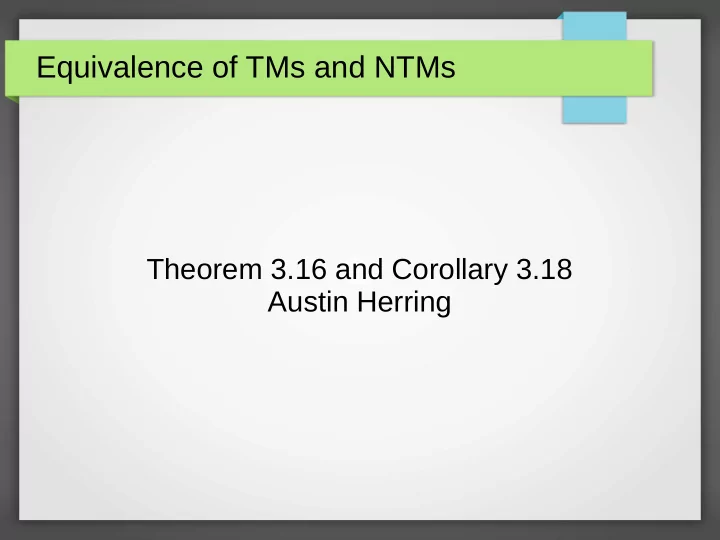

Equivalence of TMs and NTMs Theorem 3.16 and Corollary 3.18 Austin Herring
Turing Machines ● A Turing machine is a 7-tuple: ( Q , Σ, Γ, δ, q 0 , q accept , q reject ) – Q is the set of states – Σ is the input alphabet – Γ is the tape alphabet – δ: Q x Γ → Q x Γ x {L, R} is the transition function – q 0 ∈ Q is the start state – q accept ∈ Q is the accept state – q reject ∈ Q is the reject state
Nondeterministic Turing Machines An NTM is a 7-tuple: ( Q , Σ, Γ, δ, q 0 , q accept , q reject ) ● Q is the set of states – Σ is the input alphabet – Γ is the tape alphabet – δ: Q x Γ → P ( Q x Γ x {L, R}) is the transition function – q 0 ∈ Q is the start state – q accept ∈ Q is the accept state – q reject ∈ Q is the reject state – Note that the only difference is the transition function ● For an NTM, in any state, it can nondeterministically choose any transition from – the set of transitions returned by δ Can be considered a tree – each choice of transition in the transition function is a new ● branch in the tree
Proof Introduction ● Want to prove: – Every nondeterministic Turing machine has an equivalent Turing machine ● Proof method: – Use the view of the NTM N 's computation as a tree – Have a deterministic Turing machine D perform a breadth-first search on this tree
Proof ● Let D be a three tape Turing machine – Tape 1 contains the input string w – Tape 2 contains a copy of N 's tape on some branch of computation – Tape 3 maintains information on where D is in N 's tree ● A string of numbers represents following that path in the tree – e.g., 123 means the root's first child, then that node's second child, then that node's third child ● Note that some strings may not correspond to real computations in N
Proof 1. Initially, tape 1 will contain w and tapes 2 and 3 will be empty 2. Copy the contents of tape 1 to tape 2 3. Simulate N on tape 2 along a particular branch using input w . a)Before each step of N , look at the next symbol on tape 3 to determine which choice of transition to make. b)If tape 3 has no more symbols, a reject state is found, or the string on tape 3 is invalid, go to stage 4 c) If an accept state is found, accept 4. Replace the string on tape 3 with the next string in lexicographical order. Simulate this new branch by going to stage 2
Corollary ● A language is Turing-recognizable if and only if some nondeterministic Turing machine recognizes it ● Proof: – A deterministic TM is a nondeterministic TM that only ever has one element in the set returned by δ ● Means that NTMs can recognize all languages TMs recognize – Other direction follows from prior proof, i.e., TMs can simulate NTMs ● Means that TMs recognize all languages NTMs recognize
Questions
Recommend
More recommend